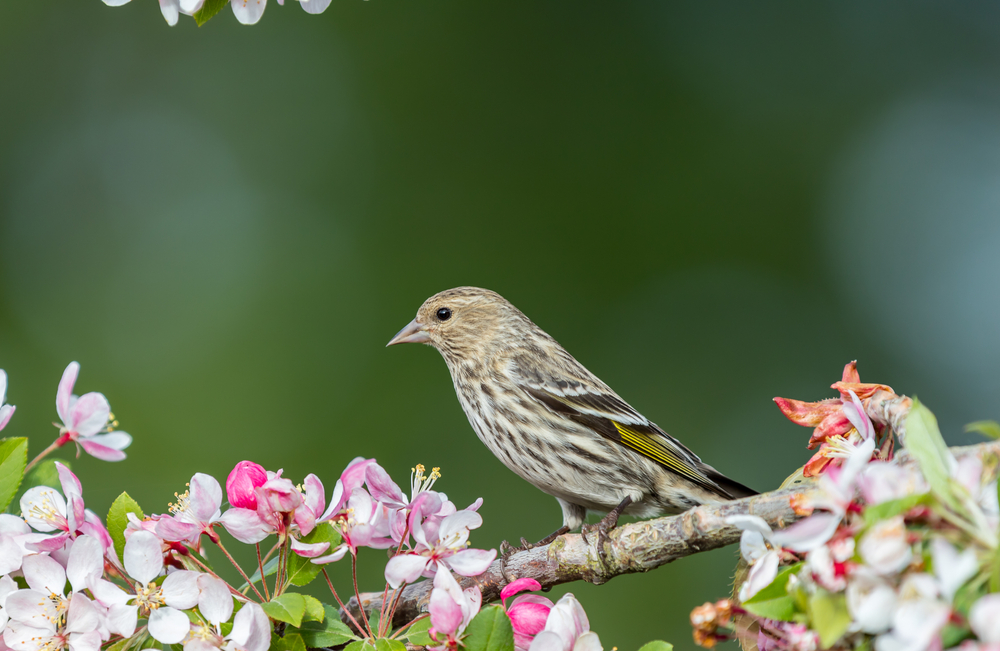The pine siskin is a North American songbird found in almost every state. They are equipped to handle some intensely cold temperatures, well below freezing. They have a size similar to the American goldfinch and brown and white coloring similar to that of a house sparrow.
While these nomadic songbirds migrate north to Canada during the breeding season, they reside high in the treetops of conifer trees and aren’t deterred by a little cold weather. Many pine siskins can withstand temperatures as cold as –94°F (–70°C)!
One never encounters a singular pine siskin. These social songbirds travel in large flocks year-round.
They travel throughout much of North America in search of food and never take up camp in one place for too long.
What Does a Pine Siskin Look Like?
Pine siskins, scientific name Spinus pinus, is a member of the finch (Fringillidae) family. They are small with petite features similar to many finches, such as the common redpoll but without striking coloring.
They have very muted shades of brown and white with just a dash of yellow on their wing bars. Their short, sharp beak is used for cracking open seeds of shells, thistle, or sunflower seeds, and they are often seen hanging around bird feeders, especially in the winter months.
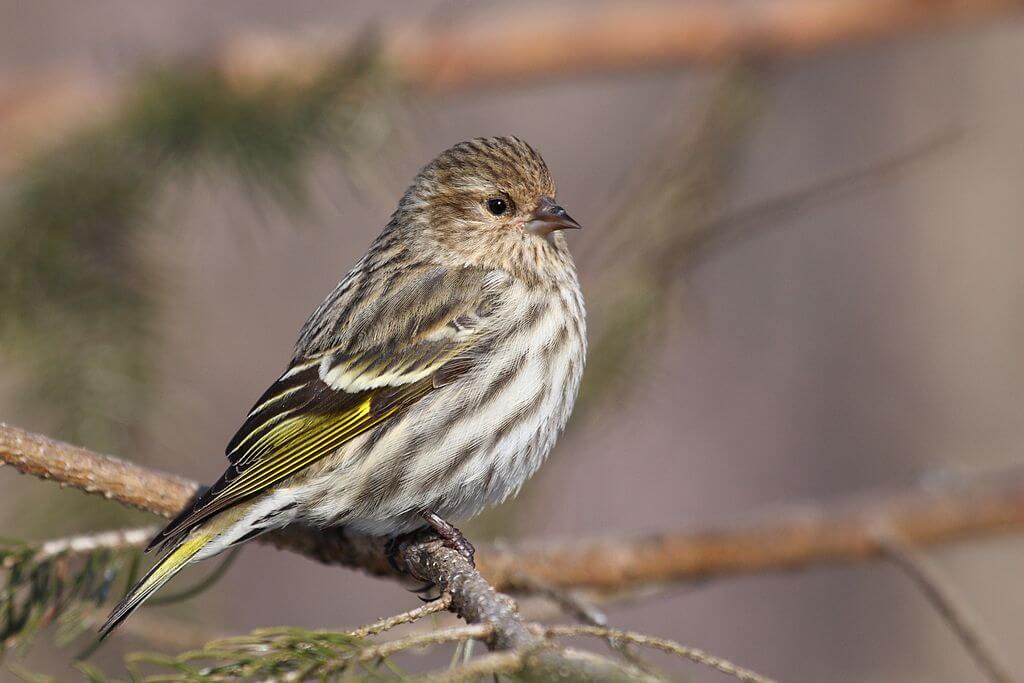
How can you tell a Pine Siskin from a goldfinch?
The main difference between pine siskins and goldfinches lies in their plumage:
Pine siskins have a streaked and mottled appearance with brownish-olive or grayish-brown backs and wings. They have fine dark streaks running along the sides of their bodies, and the underparts are lighter with subtle streaking.
The wings show yellowish wing bars, and they may have a hint of yellow on their face, especially around the base of the bill.
American goldfinches have bright lemon-yellow bodies with black wings and a black cap in their breeding plumage. They have white wing bars and a contrasting black tail.
Females and non-breeding males have a more subdued appearance, with olive-brown plumage and less yellow on the body. Lesser goldfinches have a black back and cap, bright yellow underparts, and white wing bars.

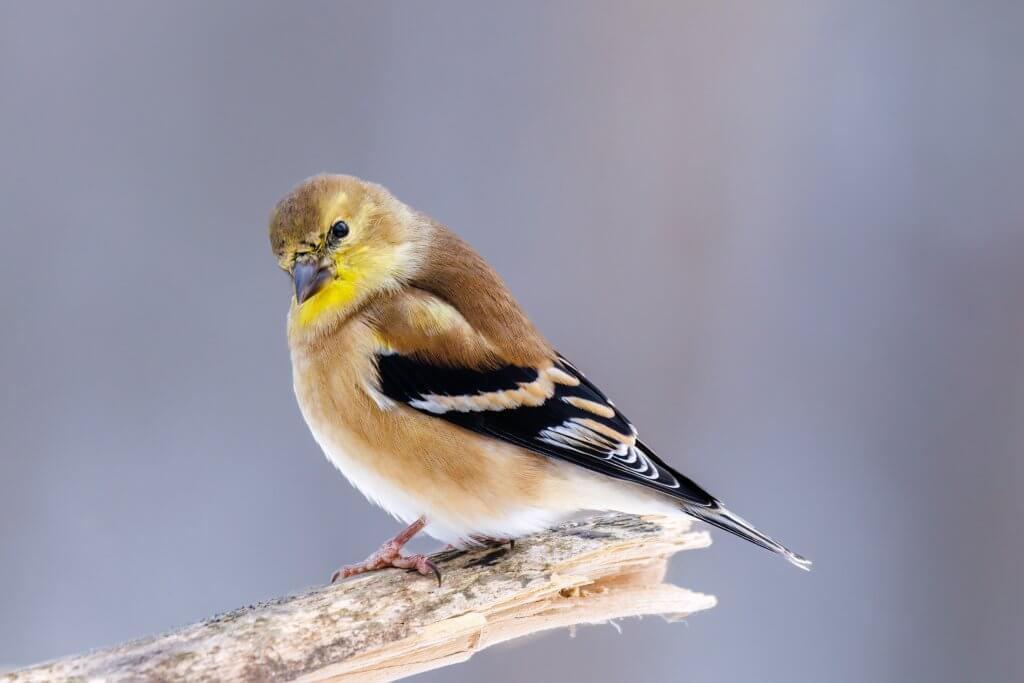
What is the difference between a Pine Siskin and a sparrow?
Pine siskins are finches with streaked plumage, a slender bill, and a relatively small size, while sparrows are a diverse group of small passerine birds with varying plumage patterns and habits.
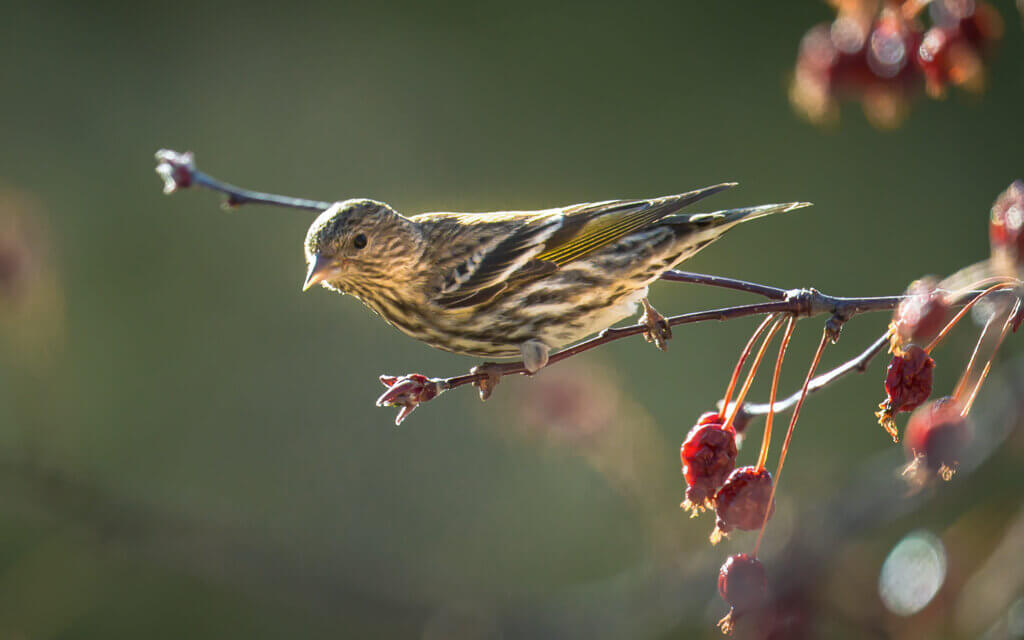
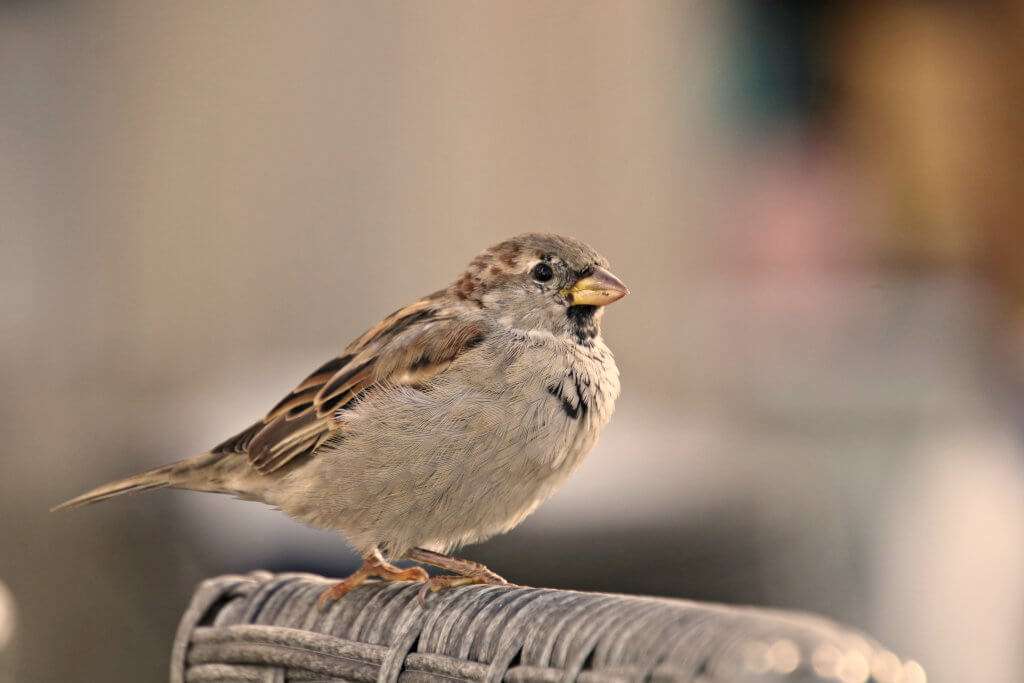
How Long Does a Pine Siskin Live?
The lifespan of pine siskins in the wild can vary, but on average, they typically live around 2 to 4 years.
What is the habitat of the Pine Siskin?
Pine Siskins are rarely found on ground level. During the breeding season, pine siskins can be found in the northern parts of North America, including Canada and parts of the northern United States, where they build their nests and forage for seeds and nuts.
With similar movements to that of a woodpecker, the pine siskin uses its strong legs to navigate the tree trunk and even can hang upside down in search of a particularly hard-to-reach seed.
In the winter, pine siskins are known for their nomadic and irruptive movements. They may move southward and can be found in various locations throughout the United States, including in more southern states where they are not typically found during the breeding season.
Do Pine Siskins migrate?
Yes, pine siskins are migratory birds. They undertake seasonal migrations, moving between different regions in response to changes in food availability and weather conditions.
No matter where you are in the United States, there’s a good chance you can catch a glimpse of a pine siskin. Since they travel in large flocks searching for seed crops across the United States, finding them isn’t too challenging.
Their breeding range is shallow and encompasses a small strip of Canada and parts of Alaska. The best time for birdwatching is during the winter months. The pine siskin is a nomadic bird and doesn’t just set up camp in one area in the United States.
They constantly move through deciduous forests, looking for seeds, nuts, and other food sources.
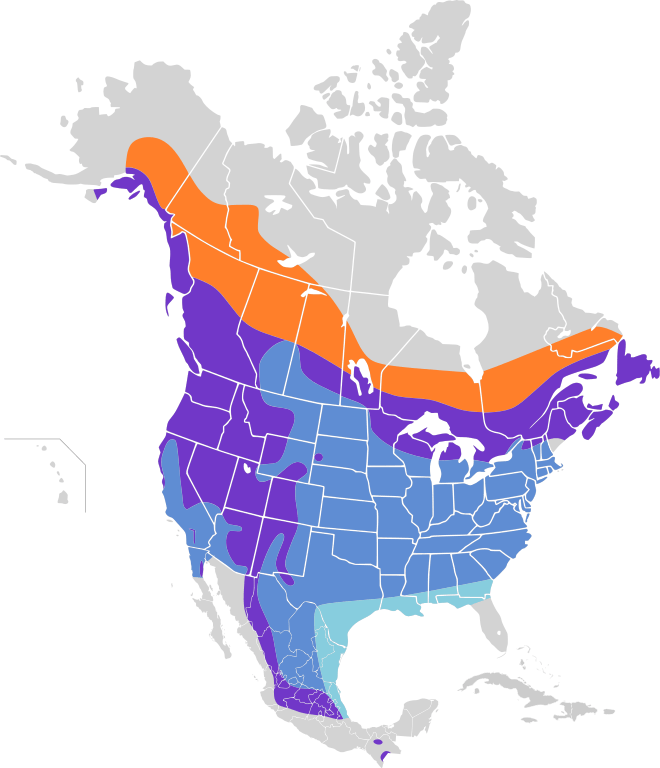
What Do Pine Siskins Eat?
One of the reasons that pine siskins travel in large flocks is in search of food sources. Even during the summer months, these Passeriformes primarily eat a plant-based diet.
While most of their diet comprises plants, they sometimes eat the occasional caterpillar or aphid, especially when feeding young birds.
Pine siskins are very popular visitors to backyard feeders and can make quick work of suet or hanging thistle feeders in their wintering grounds.
What About Mating and Nesting?
Unlike other songbirds, the mating season for the pine siskin doesn’t start in the spring. Since pine siskins travel in large flocks year-round, mated pairs typically form during the winter.
To attract a mate, the male pine siskin flies in circles over the female while singing a courtship song and bringing her food. Once the female selects her mate, she begins to build her nest.
Pine siskin nests are small, compact, and made of materials such as grass, weeds, rootlets, and even lichens. The female builds much of the nest. However, in some instances, the male helps deliver building materials.
Nests are found in the horizontal branches on a conifer tree, high off the ground, with plenty of overhead protection from predators. Since many nests are located so far away from the tree trunk, pine siskin’s nests aren’t the most secure in the world. One gust of wind may find the nest toppling to the ground.
How many eggs does a Pine Siskin lay?
The average clutch size for a pine siskin is three to five eggs, and the female incubates the eggs for up to thirteen days. The male pine siskin doesn’t help with incubation but helps by delivering food to the female.
Despite their love of cooler weather, the pine siskin only raises one brood of young birds per season. In some instances, they may raise two (or try for a second if the first nest is destroyed), but it’s rare.
What is Pine Siskin’s song?
The pine siskin loves to chatter away! While its song sounds more like a jumbled mess of musical notes than a song, it can make some unique noises.
Other finch species (such as the house finch or American goldfinch) have more fluid, warbling notes to their songs. The pine siskin, on the other hand, has a call that sounds blurry and grave.
One of their most recognizable calls is their zreeet contact calls. They use this crescendoing zreeet call to locate and communicate with other flock members. With just one note, the pine siskin can alert their entire community to a good food source or warn them of a predator.
What are the best seeds to feed a Pine Siskin?
- Nyjer (Thistle) Seeds: These tiny, oil-rich seeds come from the African yellow daisy (Guizotia abyssinica) and are also known as thistle seeds. Despite the common name, they are not true thistle seeds, but they are often referred to as such in the birdfeeding industry. Pine siskins are particularly fond of nyjer seeds, and a feeder filled with these seeds is likely to attract them.
- Sunflower Seeds: Pine siskins will readily feed on black oil sunflower seeds as well. While nyjer seeds are their favorite, sunflower seeds can be a good alternative if you don’t have nyjer seeds available. Opt for sunflower chips or hulled sunflower seeds to minimize waste and make it easier for the birds to feed.
- Other Small Seeds: Pine siskins may also eat other small seeds, such as millet and canary seeds. Including a mix of small seeds along with nyjer and sunflower seeds in your feeder can provide variety and attract a wider range of birds.
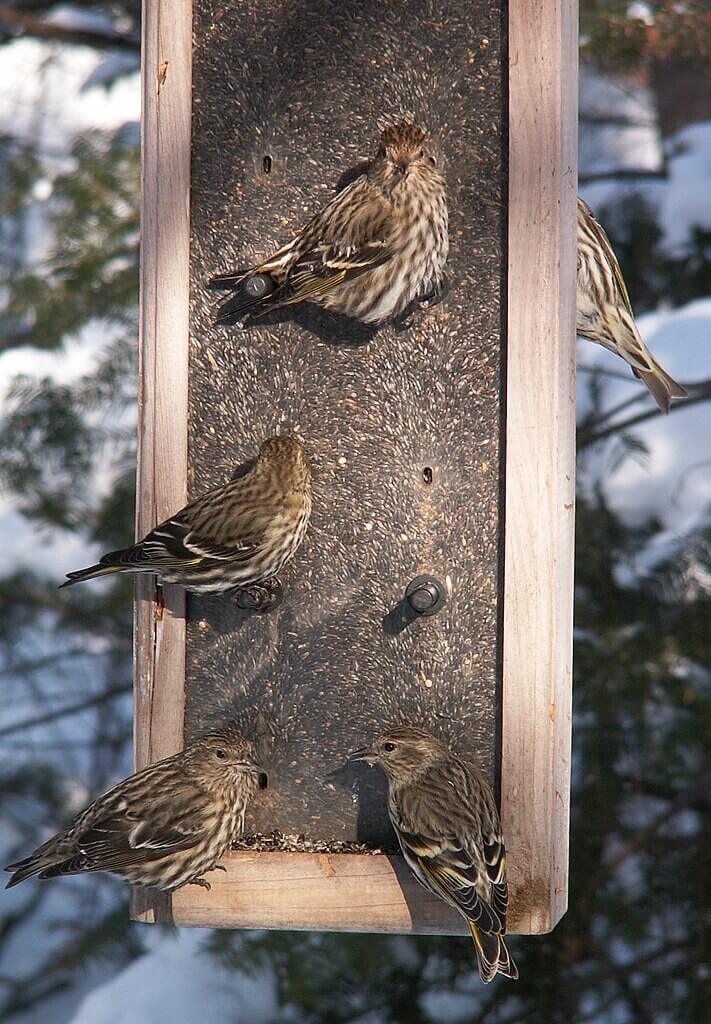
Do Pine Siskins Eat From Birdfeeders?
Yes, they do! When setting up a bird feeder for pine siskins, use a specialized nyjer or thistle seed feeder.
These feeders have smaller ports that prevent larger birds from accessing the seeds, as pine siskins prefer to feed in smaller flocks and can be easily outnumbered at a feeder by larger, more aggressive birds.
What to read next: Attract More Goldfinches To Your Backyard Using Feeders

